We start on our implementation process this week and everyone gets to work on their respective sections of work. I started learning and writing UI for our system with TKinter.

I got through many of the UI elements over the week and I plan to planning to approach the image display, video display, and database functionalities tomorrow. Below is the video I will refer to.
I also tried to get openpose to work on my laptop, but I am still getting errors based on CMake versions. My plan is to make Openpose run on my laptop as soon as possible, hopefully in the next 2 days.
I also looked through whole_body_from_image.py and keypoints_from_image.py examples in the openpose official repository. Base on the whole body example, display a sequence of poses in order can be realized by reading each image , setting up the pose datapoints in Shiheng’s cost functions, and then waiting for the user to input a correct pose. The timing could be an issue to implement and I might need to look into the Python functionalities to realize them in our system. Meanwhile, static pose evaluation can be realized with the following code as a reference:

Still, through discussions on the design review we presented this week, we noticed aspects of our project that requires more detailed considerations. In particular, the way we want to convey our pose dectection results need to be intuitive enough for our users. Also, the time interval between each verbal instruction should be different from the interval between each pose detection. I will take these into account when designing the user interface next week and reflect them in the design report that is coming up next week.
My progress for this week is still on schedule, though work for next week might be heavier than regular weeks. I plan to work some time during the fall break if the schedule for next week turns out to be too packed, but I will put priority on planning out how the api and ui should communicate and decide on a design for the ui.

